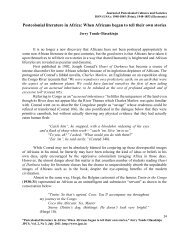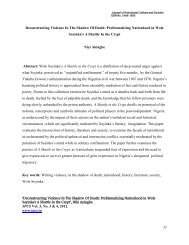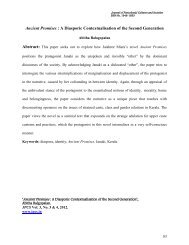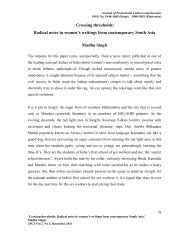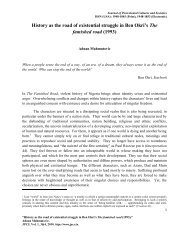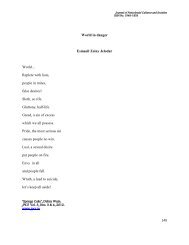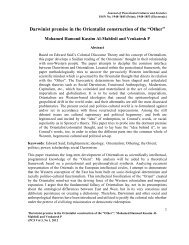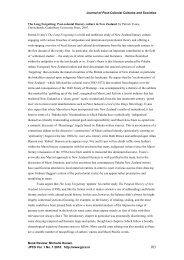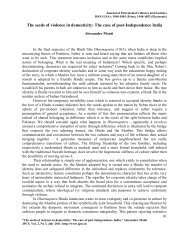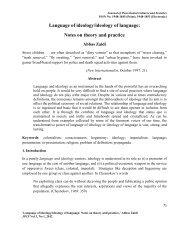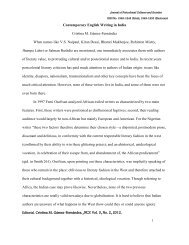An Australian tale in a Japanese story: Reading the national ... - JPCS
An Australian tale in a Japanese story: Reading the national ... - JPCS
An Australian tale in a Japanese story: Reading the national ... - JPCS
You also want an ePaper? Increase the reach of your titles
YUMPU automatically turns print PDFs into web optimized ePapers that Google loves.
Journal of Postcolonial Cultures and Societies<br />
ISSN No. 1948-1845 (Pr<strong>in</strong>t); 1948-1853 (Electronic)<br />
<strong>An</strong> <strong>Australian</strong> <strong>tale</strong> <strong>in</strong> a <strong>Japanese</strong> <strong>story</strong>:<br />
Read<strong>in</strong>g <strong>the</strong> <strong>national</strong> <strong>in</strong> Sue Brook’s <strong>Japanese</strong> <strong>story</strong><br />
Chew Yi Wei<br />
Sue Brook’s film, <strong>Japanese</strong> Story (2003) lends itself to many peculiarities. Upon hear<strong>in</strong>g its title<br />
and hav<strong>in</strong>g some perfunctory knowledge of its association with Australia, one might - due to this<br />
overt <strong>in</strong>congruity - be tempted to assume <strong>the</strong> film to be ei<strong>the</strong>r an exercise <strong>in</strong> <strong>the</strong> nation’s<br />
exoticisation of Japan, or even liken<strong>in</strong>g it to a <strong>Japanese</strong> production. Less impetuously and<br />
pejoratively, some would th<strong>in</strong>k it a film typically belong<strong>in</strong>g to <strong>the</strong> pan<strong>the</strong>on of <strong>the</strong> trans<strong>national</strong><br />
due to <strong>the</strong> presence of a <strong>Japanese</strong> actor <strong>in</strong> a supposedly all-<strong>Australian</strong> cast. Yet, should a deeper<br />
study be effected, we f<strong>in</strong>d <strong>Japanese</strong> Story to be substantially complex and more problematic than<br />
that, leav<strong>in</strong>g <strong>the</strong> above suppositions surface and simplistic. In <strong>Japanese</strong> Story, polymorphous and<br />
fluid (conceptual) worlds imbricate and syn<strong>the</strong>sise, form<strong>in</strong>g a melange thick with complexity,<br />
movement and def<strong>in</strong>itional subjectivity. Ow<strong>in</strong>g to <strong>the</strong> presence of Asian characters <strong>in</strong> <strong>the</strong> film<br />
and <strong>the</strong> external but consonant dialogue on Australia-Asia relations, <strong>the</strong> positions of <strong>Japanese</strong><br />
Story <strong>in</strong> <strong>the</strong> film <strong>in</strong>dustry both <strong>national</strong>ly and trans<strong>national</strong>ly are also <strong>in</strong>escapably implicated. My<br />
task however will be to argue for <strong>Japanese</strong> Story as be<strong>in</strong>g qu<strong>in</strong>tessentially <strong>national</strong> though it may<br />
not possess any ostensible <strong>national</strong>istic overtones. Before I proceed with an analysis of <strong>the</strong> film,<br />
contextualisation <strong>in</strong> terms of Australia-Asia relations and <strong>national</strong> c<strong>in</strong>ema is a necessity: both<br />
<strong>the</strong>se concepts are <strong>in</strong>extricably connected and <strong>the</strong>refore jo<strong>in</strong>tly scrut<strong>in</strong>ised.<br />
Australia-Asia relations<br />
The relationship between Australia and Asia has been a contested and dialectical one, especially<br />
so s<strong>in</strong>ce Prime M<strong>in</strong>ister Keat<strong>in</strong>g ushered <strong>in</strong> <strong>the</strong> policy of multiculturalism <strong>in</strong> <strong>the</strong> early to mid-<br />
1990s, call<strong>in</strong>g for Australia to be a “multicultural nation <strong>in</strong> Asia”. 1 That such a radical statement<br />
is proclaimed would <strong>in</strong>deed place Australia’s sense of self and identity <strong>in</strong> uncerta<strong>in</strong>ty and even<br />
defensiveness. With a pronounced and strong <strong>An</strong>glo-Celtic core as its colonial-ethnic l<strong>in</strong>eage,<br />
Australia has based her identity firmly on it as a form of social coherence that transcends<br />
transition and change. 2 As a complement to this assurance of selfhood, <strong>the</strong> White Australia<br />
Policy (1901 -1973) doubtless played a substantial role <strong>in</strong> accentuat<strong>in</strong>g <strong>the</strong> immovability and<br />
stability of <strong>Australian</strong> identity far removed from any locale beyond <strong>the</strong> borders of <strong>Australian</strong><br />
territory; more significantly, it succeeded <strong>in</strong> dist<strong>in</strong>guish<strong>in</strong>g and separat<strong>in</strong>g Whites from Non-<br />
Whites, relegat<strong>in</strong>g <strong>the</strong> latter as <strong>the</strong> conspicuous O<strong>the</strong>r. S<strong>in</strong>ce <strong>the</strong> 1970s however, <strong>the</strong> walls and<br />
spoils of colonialism <strong>in</strong> Australia have given way to <strong>the</strong> <strong>in</strong>exorable tide of globalisation,<br />
destabilis<strong>in</strong>g and shatter<strong>in</strong>g almost all previously held and grounded notions of <strong>Australian</strong><br />
identity. Even more so today, Australia can no longer ignore <strong>the</strong> shift<strong>in</strong>g sands of its modernity<br />
and sense of self.<br />
Asia has been by far one of <strong>the</strong> island cont<strong>in</strong>ent’s most extensive but uneasy bedfellows<br />
and has <strong>in</strong>variably shaped <strong>the</strong> way Australia perceives itself, with politicians, artists and<br />
‘<strong>An</strong> <strong>Australian</strong> <strong>tale</strong> <strong>in</strong> a <strong>Japanese</strong> <strong>story</strong>: Read<strong>in</strong>g <strong>the</strong> <strong>national</strong> <strong>in</strong> Sue Brook’s <strong>Japanese</strong> <strong>story</strong>,’ Chew Yi Wei<br />
<strong>JPCS</strong> Vol 1, No 1, 2010<br />
46
Journal of Postcolonial Cultures and Societies<br />
ISSN No. 1948-1845 (Pr<strong>in</strong>t); 1948-1853 (Electronic)<br />
<strong>in</strong>tellectuals at <strong>the</strong> forefront of <strong>the</strong> debate: is Australia really a part of Asia? Echo<strong>in</strong>g Prime<br />
M<strong>in</strong>ister Keat<strong>in</strong>g’s call, one cannot say for sure if this question has really been answered at all –<br />
even till today. Australia is putatively seen to be part of Asia due to geographic <strong>in</strong>evitabilities.<br />
<strong>An</strong>glican Bishop E.H Burgmann asserted once that “geographically, [<strong>Australian</strong>s] are Oriental<br />
[and] not European. [Australia] is an island just off <strong>the</strong> south east coast of Asia and [is] part of<br />
<strong>the</strong> Oriental world. There [Australia’s] fate is set. [Australia] is <strong>the</strong>re geographically and <strong>the</strong>re<br />
[she] will stay”. 3 More pragmatically and rema<strong>in</strong><strong>in</strong>g still <strong>in</strong> <strong>the</strong> ve<strong>in</strong> of Burgmann, Jamie Mackie<br />
agrees that Australia is <strong>in</strong>disputably part of Asia but adds that her “economic prospects have<br />
become bound up <strong>in</strong>exorably with <strong>the</strong> great developments happen<strong>in</strong>g <strong>in</strong> <strong>the</strong> ma<strong>in</strong> Asian countries<br />
s<strong>in</strong>ce <strong>the</strong> end of <strong>the</strong> colonial era”. 4 There are of course o<strong>the</strong>rs who refute <strong>the</strong> claims of both<br />
Burgmann and Mackie and <strong>in</strong>sist on Australia be<strong>in</strong>g essentially European with <strong>the</strong>ir shared and<br />
common cultural memory from <strong>the</strong> Greeks and Romans and <strong>the</strong> Enlightenment. 5 The absence of<br />
any conclusion or consensus <strong>in</strong> this variegated debate underscores <strong>the</strong> fact that constant<br />
negotiation is perhaps <strong>the</strong> on-go<strong>in</strong>g project of <strong>Australian</strong> identity.<br />
Increas<strong>in</strong>gly, aversion to Asians is slowly but surely dissipat<strong>in</strong>g with <strong>Australian</strong>s tak<strong>in</strong>g a<br />
less parochial and more progressive worldview. Today <strong>Australian</strong> understand<strong>in</strong>gs are generally<br />
more ref<strong>in</strong>ed and <strong>the</strong> images of Asia are more positive”. 6 Still, most <strong>Australian</strong>s rema<strong>in</strong> wary of<br />
<strong>the</strong> notion that <strong>the</strong>y are unadulterated Orientals; “[d]epend<strong>in</strong>g on <strong>the</strong>ir <strong>in</strong>terests, <strong>Australian</strong>s may<br />
now have to construct and negotiate multiple identities, new and old, and to learn to deploy <strong>the</strong>m<br />
<strong>in</strong> different contexts. This means mov<strong>in</strong>g beyond notions of a s<strong>in</strong>gle identity tied to a nationstate”.<br />
7 It is this very act of “mov<strong>in</strong>g beyond” that def<strong>in</strong>es <strong>the</strong> <strong>Australian</strong> sense of nationhood as<br />
well. Theirs is an identity <strong>in</strong> crisis and an identity <strong>in</strong> motion. <strong>An</strong>d <strong>the</strong> film <strong>in</strong>dustry, be<strong>in</strong>g<br />
watchers of culture must surely be privy to and proactive <strong>in</strong> tackl<strong>in</strong>g this enterprise.<br />
National C<strong>in</strong>ema<br />
The concept of “<strong>national</strong> c<strong>in</strong>ema” has never been straightforward or unilateral. National c<strong>in</strong>emas<br />
have def<strong>in</strong>ed <strong>the</strong>mselves accord<strong>in</strong>g to <strong>the</strong> historical circumstances <strong>the</strong>y found <strong>the</strong>mselves <strong>in</strong> as<br />
well as aga<strong>in</strong>st a variety of forces. Stephen Crofts attempts to deal with this loaded issue by<br />
separat<strong>in</strong>g <strong>the</strong> different types of <strong>national</strong> c<strong>in</strong>emas <strong>in</strong>to categories: “[National c<strong>in</strong>emas] have<br />
performed quite dist<strong>in</strong>ct functions <strong>in</strong> relation to <strong>the</strong> state. They have had very different<br />
relationships to Hollywood. Divergent claims have been made for <strong>the</strong>m. They adopt a range of<br />
formal and generic characteristics. They are ‘<strong>national</strong> c<strong>in</strong>emas’ <strong>in</strong> a variety of ways”. 8 Indeed,<br />
Crofts’ categories are not at all mutually exclusive. National c<strong>in</strong>ema, be<strong>in</strong>g conceptually broad<br />
and fluid does not rest on <strong>in</strong>dependent, prescriptive def<strong>in</strong>itions; <strong>the</strong> abovementioned categories<br />
will <strong>in</strong>evitably overlap when we deal with <strong>the</strong>m <strong>in</strong> relation to globalisation, hi<strong>story</strong>, politics, film<br />
production and film distribution. One’s <strong>national</strong> c<strong>in</strong>ema can necessarily be ano<strong>the</strong>r’s<br />
trans<strong>national</strong> c<strong>in</strong>ema.<br />
Benedict <strong>An</strong>derson’s oft-asserted notion of <strong>the</strong> nation as an imag<strong>in</strong>ed community provides<br />
a very useful framework <strong>in</strong> this debate. Higson builds on <strong>An</strong>derson by stat<strong>in</strong>g that “it is now<br />
conventional to def<strong>in</strong>e <strong>the</strong> nation as <strong>the</strong> mapp<strong>in</strong>g of an imag<strong>in</strong>ed community with a secure and<br />
shared identity and sense of belong<strong>in</strong>g, on to a carefully demarcated geo-political space [...]<br />
‘<strong>An</strong> <strong>Australian</strong> <strong>tale</strong> <strong>in</strong> a <strong>Japanese</strong> <strong>story</strong>: Read<strong>in</strong>g <strong>the</strong> <strong>national</strong> <strong>in</strong> Sue Brook’s <strong>Japanese</strong> <strong>story</strong>,’ Chew Yi Wei<br />
<strong>JPCS</strong> Vol 1, No 1, 2010<br />
47
Journal of Postcolonial Cultures and Societies<br />
ISSN No. 1948-1845 (Pr<strong>in</strong>t); 1948-1853 (Electronic)<br />
Those who <strong>in</strong>habit nations with a strong sense of self-identity are encouraged to imag<strong>in</strong>e<br />
<strong>the</strong>mselves as members of a coherent, organic community, rooted <strong>in</strong> <strong>the</strong> geographical space,<br />
with well-established <strong>in</strong>digenous traditions”. 9 There is a problem that arises with his assertion:<br />
<strong>the</strong> conventional def<strong>in</strong>itions of a nation hav<strong>in</strong>g a secure identity with<strong>in</strong> a particular geopolitical<br />
space notwithstand<strong>in</strong>g, nations are <strong>in</strong> actuality made up of very divided communities who live<br />
with faultl<strong>in</strong>es and fractures ra<strong>the</strong>r than coherence and unity. A nation is made up of city as well<br />
as non-city dwellers, immigrants, exiles and diasporic communities who contribute to <strong>the</strong><br />
diversity of its be<strong>in</strong>g, thus to say that <strong>the</strong> mak<strong>in</strong>gs of a nation are solely based on its <strong>in</strong>digenous<br />
traditions would be to negate <strong>the</strong> differences between <strong>the</strong>se very dissimilar communities.<br />
Extend<strong>in</strong>g <strong>An</strong>derson’s argument <strong>the</strong>n, a nation is not only an imag<strong>in</strong>ed community but it is more<br />
significantly, made up of many imag<strong>in</strong>ed communities supposedly dwell<strong>in</strong>g with<strong>in</strong> a fixed geopolitical<br />
boundary. Should we explore this argument fur<strong>the</strong>r, we would also realise that <strong>the</strong><br />
bus<strong>in</strong>ess of how a certa<strong>in</strong> community def<strong>in</strong>es itself and <strong>the</strong>ir def<strong>in</strong><strong>in</strong>g of <strong>the</strong> nation are <strong>in</strong> fact<br />
exercises <strong>in</strong> and of power. Those who demarcate and del<strong>in</strong>eate boundaries – physical or not –<br />
presuppose a certa<strong>in</strong> authority on <strong>the</strong>ir parts. Due to <strong>the</strong> existence of <strong>the</strong>se diverse <strong>national</strong><br />
stakeholders who possess a substantial role <strong>in</strong> <strong>the</strong> nation-build<strong>in</strong>g/def<strong>in</strong><strong>in</strong>g project, it would be<br />
irresponsible and simplistic to state that a nation’s borders have eroded and dismiss <strong>the</strong> concepts<br />
of <strong>the</strong> Nation (and hence National C<strong>in</strong>ema) as be<strong>in</strong>g merely an excuse for maudl<strong>in</strong> <strong>national</strong>ism.<br />
Nations want to exist and <strong>the</strong>y will cont<strong>in</strong>ue to do so – all <strong>the</strong> more <strong>in</strong> <strong>the</strong> face of globalisation.<br />
Tensions and ruptures will surely exist as <strong>the</strong> local tries to reconcile with <strong>the</strong> global; yet, it is this<br />
anxiety and search that make up dynamism and syn<strong>the</strong>sis of what goes on with<strong>in</strong> those carefully<br />
demarcated map l<strong>in</strong>es.<br />
As my essay is on <strong>the</strong> subject of film discourses, I will concentrate on <strong>the</strong> film <strong>in</strong>dustry as<br />
one of <strong>the</strong> major stakeholders <strong>in</strong> detail<strong>in</strong>g and def<strong>in</strong><strong>in</strong>g a nation’s identity and experience, it<br />
hav<strong>in</strong>g <strong>the</strong> power to create a certa<strong>in</strong> image of a nation, package it and reproduce for its target<br />
audience. It is at this po<strong>in</strong>t that we must pause to consider who and what a <strong>national</strong> audience is.<br />
Like National C<strong>in</strong>ema, a <strong>national</strong> audience is a plural organism. While production can be tailored<br />
to an imag<strong>in</strong>ed profile of a <strong>national</strong> audience, reception can necessarily vary. How <strong>the</strong>n can a<br />
film be considered ‘<strong>national</strong>’ should it be met with such a dynamic and complex <strong>in</strong>terplay of<br />
factors? Is achiev<strong>in</strong>g a <strong>national</strong> c<strong>in</strong>ema or <strong>in</strong>deed mak<strong>in</strong>g a film “<strong>national</strong>” an exercise <strong>in</strong><br />
parochialism and futility?<br />
Despite <strong>the</strong> problems that exist when it comes to understand<strong>in</strong>g National C<strong>in</strong>ema, this<br />
essay will argue that <strong>Japanese</strong> Story is an essentially <strong>national</strong> film. In this ve<strong>in</strong> <strong>the</strong>n, <strong>the</strong><br />
understand<strong>in</strong>g of <strong>Australian</strong> (identity) can also run <strong>the</strong> risk of be<strong>in</strong>g pigeon -holed and fixed.<br />
Higson, <strong>in</strong> his earlier book The Concept of National C<strong>in</strong>ema def<strong>in</strong>ed <strong>national</strong> c<strong>in</strong>emas to be “<strong>the</strong><br />
product of ‘home’ and ‘away’, between <strong>the</strong> identification of <strong>the</strong> homely and <strong>the</strong> assumption that<br />
it is quite dist<strong>in</strong>ct from what happens elsewhere. In this sense, <strong>the</strong>re are two central conceptual<br />
means of identify<strong>in</strong>g <strong>the</strong> imag<strong>in</strong>ary coherence or specificity of a <strong>national</strong> c<strong>in</strong>ema. On <strong>the</strong> o<strong>the</strong>r<br />
hand, a <strong>national</strong> c<strong>in</strong>ema seems to look <strong>in</strong>ward, reflect<strong>in</strong>g on <strong>the</strong> nation itself, on its past, present<br />
and future, its cultural heritage, its <strong>in</strong>digenous traditions, its sense of common identity and<br />
cont<strong>in</strong>uity. On <strong>the</strong> o<strong>the</strong>r hand, a <strong>national</strong> c<strong>in</strong>ema seems to look out across borders, assert<strong>in</strong>g its<br />
difference from o<strong>the</strong>r <strong>national</strong> c<strong>in</strong>emas, proclaim<strong>in</strong>g its sense of o<strong>the</strong>rness”. 10 Later, Higson f<strong>in</strong>ds<br />
his earlier def<strong>in</strong>ition problematic as “it tends to assume that <strong>national</strong> identity and tradition are<br />
‘<strong>An</strong> <strong>Australian</strong> <strong>tale</strong> <strong>in</strong> a <strong>Japanese</strong> <strong>story</strong>: Read<strong>in</strong>g <strong>the</strong> <strong>national</strong> <strong>in</strong> Sue Brook’s <strong>Japanese</strong> <strong>story</strong>,’ Chew Yi Wei<br />
<strong>JPCS</strong> Vol 1, No 1, 2010<br />
48
Journal of Postcolonial Cultures and Societies<br />
ISSN No. 1948-1845 (Pr<strong>in</strong>t); 1948-1853 (Electronic)<br />
already fully formed and fixed <strong>in</strong> place”. 11 While Higson’s later argument holds water <strong>in</strong> <strong>the</strong><br />
light of what has been discussed, we cannot discount <strong>the</strong> significance of his earlier take on<br />
National C<strong>in</strong>ema. While it is tempt<strong>in</strong>g to lump <strong>Japanese</strong> Story as be<strong>in</strong>g part of <strong>the</strong> pan<strong>the</strong>on of<br />
trans<strong>national</strong> film due to its East-West/<strong>Japanese</strong>-<strong>Australian</strong> flavour, we must note that <strong>national</strong><br />
identity <strong>in</strong> <strong>the</strong> modern nation state – and <strong>in</strong> this case <strong>Australian</strong> (and <strong>Japanese</strong>) identity <strong>in</strong> <strong>the</strong><br />
face of each O<strong>the</strong>r – can <strong>in</strong> fact solidify each dist<strong>in</strong>ct identity even more. Like Higson said<br />
earlier, <strong>national</strong> c<strong>in</strong>emas do proclaim <strong>the</strong> difference between <strong>the</strong> nation and <strong>the</strong> world, between<br />
<strong>the</strong> global and <strong>the</strong> local – and <strong>the</strong> film does just that. The need to give one’s identity shape, to<br />
darken <strong>the</strong> l<strong>in</strong>es between <strong>the</strong> ambiguous <strong>in</strong>terstices that globalisation has created seems to<br />
surface even more today. Truly, “[g]lobalisation, paradoxically, has led to a streng<strong>the</strong>n<strong>in</strong>g of<br />
local ties, allegiances, and identity politics with<strong>in</strong> different nation-states formations, even though<br />
what may emerge is what Stuart Hall calls that more ‘tricky version ‘<strong>the</strong> local’ which operates<br />
with<strong>in</strong>, and has been thoroughly reshaped by ‘<strong>the</strong> global’ and operates largely with<strong>in</strong> its<br />
logic’”. 12<br />
A <strong>national</strong> c<strong>in</strong>ema is constantly subject to change and discovery and filmmakers, be<strong>in</strong>g at<br />
once ambassadors and critics of <strong>the</strong>ir culture are appreciat<strong>in</strong>g <strong>the</strong> need to adopt a self-reflexive<br />
disposition and approach <strong>in</strong> <strong>the</strong> way <strong>the</strong>y construct <strong>the</strong>ir films stylistically and <strong>the</strong>matically. O’<br />
Regan <strong>the</strong>refore states emphatically and truthfully that “every film-mak<strong>in</strong>g culture appropriates,<br />
raids and reconstructs cultural elements from outside itself <strong>the</strong>reby <strong>in</strong>digeniz<strong>in</strong>g <strong>the</strong> concept, <strong>the</strong><br />
style[.]”. 13 Consequently, a hybrid is formed, open<strong>in</strong>g <strong>the</strong> floodgates for syn<strong>the</strong>ses and<br />
regeneration of what a <strong>national</strong> c<strong>in</strong>ema can be.<br />
<strong>Japanese</strong> Story is a film that is both <strong>in</strong>trospective and outward-look<strong>in</strong>g. It understands that<br />
<strong>national</strong> identity though commonly situated <strong>in</strong> <strong>the</strong> local, also has a global proclivity. One has to<br />
be able to look out <strong>in</strong> order to look <strong>in</strong> and vice versa. Most importantly, it does not over-simplify<br />
<strong>Australian</strong> identity but performs and negotiates <strong>the</strong> nation’s local/global disruptions and<br />
complexities via its <strong>the</strong>matic concerns as well as filmic techniques and conventions.<br />
Where Landscape C<strong>in</strong>ema meets The Male Ensemble Film<br />
Conventionally, <strong>Australian</strong> C<strong>in</strong>ema has centred its <strong>the</strong>mes, modes and styles on <strong>the</strong> “emblematic<br />
White <strong>Australian</strong> male stereotype”. 14 Be<strong>in</strong>g also genre specific, <strong>the</strong> c<strong>in</strong>ema has had a reputation<br />
of privileg<strong>in</strong>g its male protagonists and <strong>in</strong> <strong>the</strong> process, adumbrat<strong>in</strong>g <strong>the</strong> roles of female ones.<br />
<strong>Japanese</strong> Story defies and resists <strong>the</strong>se traditional mores and treads on new filmic terra<strong>in</strong>s,<br />
<strong>the</strong>reby caus<strong>in</strong>g a shift and evolution <strong>in</strong> <strong>Australian</strong> C<strong>in</strong>ema. Not los<strong>in</strong>g sight of its genre-based<br />
heritage, <strong>the</strong> film utilises but never <strong>in</strong>ternalises <strong>the</strong> dist<strong>in</strong>ct genres that pervade <strong>Australian</strong><br />
C<strong>in</strong>ema by subvert<strong>in</strong>g and challeng<strong>in</strong>g <strong>the</strong> orthodoxies of its genre-scape. In <strong>the</strong> premise of Mary<br />
Louise Pratt, <strong>the</strong> film becomes <strong>the</strong>n a “contact zone” 15 : contact zones are “social spaces where<br />
disparate cultures meet, clash and grapple with each o<strong>the</strong>r”. 16 Extend<strong>in</strong>g Pratt’s argument, <strong>the</strong><br />
contact zone is a space <strong>in</strong> <strong>the</strong> film where a range of genres meet and underm<strong>in</strong>e each o<strong>the</strong>r on<br />
many levels both <strong>in</strong> <strong>the</strong> diegetic and non-diegetic worlds.<br />
‘<strong>An</strong> <strong>Australian</strong> <strong>tale</strong> <strong>in</strong> a <strong>Japanese</strong> <strong>story</strong>: Read<strong>in</strong>g <strong>the</strong> <strong>national</strong> <strong>in</strong> Sue Brook’s <strong>Japanese</strong> <strong>story</strong>,’ Chew Yi Wei<br />
<strong>JPCS</strong> Vol 1, No 1, 2010<br />
49
Journal of Postcolonial Cultures and Societies<br />
ISSN No. 1948-1845 (Pr<strong>in</strong>t); 1948-1853 (Electronic)<br />
“The natural sett<strong>in</strong>g is ever present <strong>in</strong> location shoot<strong>in</strong>g across all <strong>the</strong> genres of current<br />
production with<strong>in</strong> <strong>the</strong> <strong>Australian</strong> film <strong>in</strong>dustry”. 17 Shot ma<strong>in</strong>ly <strong>in</strong> <strong>the</strong> Pilbara Desert, <strong>Japanese</strong><br />
Story <strong>the</strong>n relies heavily on <strong>the</strong> oft-used and familiar genre of Landscape C<strong>in</strong>ema. In <strong>the</strong> open<strong>in</strong>g<br />
sequence, we see <strong>the</strong> camera undertak<strong>in</strong>g a long, track<strong>in</strong>g shot of <strong>the</strong> vast and <strong>in</strong>tractable<br />
<strong>Australian</strong> desert. Also, <strong>the</strong> distant and unimpos<strong>in</strong>g camera work — <strong>the</strong> camera does not ever<br />
descend but rema<strong>in</strong>s firmly from a height above ground — allows <strong>the</strong> magnificence and presence<br />
of <strong>the</strong> <strong>Australian</strong> desert to dom<strong>in</strong>ate and form <strong>the</strong> prevail<strong>in</strong>g backdrop of <strong>the</strong> film’s narrative.<br />
Here, we see no discernible subject but <strong>the</strong> monolithic and <strong>in</strong>timidat<strong>in</strong>g space of red, proffer<strong>in</strong>g<br />
at once <strong>the</strong> notion of <strong>the</strong> landscape as subject and text. While Sandy’s relationship with <strong>the</strong> land<br />
is met with more awareness due to her be<strong>in</strong>g local, as compared to Hiro’s fasc<strong>in</strong>ation with its<br />
colossal immensity, she rema<strong>in</strong>s herself an alien and foreigner to <strong>the</strong> deep <strong>in</strong>terior of Australia.<br />
That <strong>the</strong> land evokes <strong>in</strong> <strong>the</strong>m such differ<strong>in</strong>g emotions flaunts clearly its status as Australia’s<br />
<strong>national</strong> and cultural edifice. Hiro, be<strong>in</strong>g from Japan and familiar only with his country’s<br />
claustrophobia views <strong>the</strong> land through romanticised and tourist lenses. In <strong>the</strong> <strong>in</strong>itial stages, Hiro,<br />
like most unsuspect<strong>in</strong>g tourists, lets his excitement and enthralment with <strong>the</strong> land to overcome<br />
him and <strong>in</strong>sists with much chauv<strong>in</strong>ism that Sandy drive fur<strong>the</strong>r <strong>in</strong>land. His <strong>in</strong>cipient impression<br />
of <strong>the</strong> land is later obfuscated and shattered when <strong>the</strong>ir vehicle gets bogged. Both characters are<br />
thus subjugated to <strong>the</strong> land, never hav<strong>in</strong>g any form of dom<strong>in</strong>ion over it. Truly, <strong>the</strong> expression<br />
terra nullius exemplifies <strong>the</strong> <strong>Australian</strong> Outback. It is no respecter of mascul<strong>in</strong>ity or <strong>national</strong>ity.<br />
It is no co<strong>in</strong>cidence too that <strong>the</strong> Landscape Genre exists as a subset of <strong>the</strong> Male Ensemble<br />
Film. Rayner suggests that:<br />
“[t]he unique <strong>Australian</strong> environment is foregrounded <strong>in</strong> numerous productions<br />
as <strong>the</strong> landscape shap<strong>in</strong>g <strong>the</strong> <strong>Australian</strong> (mascul<strong>in</strong>e) <strong>national</strong> type, as <strong>the</strong> primary<br />
<strong>in</strong>fluence upon <strong>the</strong> development of <strong>national</strong> character, and as a dist<strong>in</strong>ctive<br />
resource or sell<strong>in</strong>g po<strong>in</strong>t to be used to an aes<strong>the</strong>tic and commercial advantage<br />
[…] However, <strong>the</strong> celebration of a dist<strong>in</strong>ctive landscape, as an <strong>in</strong>tegral part of<br />
filmic and cultural identity, is undertaken primarily <strong>in</strong> male-centred dramas […]<br />
because of <strong>the</strong> def<strong>in</strong>ition of <strong>national</strong>ity and mascul<strong>in</strong>ity through a respectful<br />
and/or competitive relationship with <strong>the</strong> land”. 18<br />
Not only is <strong>the</strong>re an overt process of <strong>national</strong>is<strong>in</strong>g ev<strong>in</strong>ced, here we see also a gender<strong>in</strong>g of <strong>the</strong><br />
land and a subversion of <strong>the</strong> traditional filmic topos. Sandy and Hiro, boldly travers<strong>in</strong>g <strong>the</strong><br />
territory belong<strong>in</strong>g to <strong>the</strong> hegemonic figure of <strong>the</strong> <strong>Australian</strong> While Male are accord<strong>in</strong>gly placed<br />
as <strong>the</strong> O<strong>the</strong>r(s) aga<strong>in</strong>st him. This <strong>in</strong>ternal negotiation lends itself suitably to <strong>the</strong> matrix of <strong>the</strong><br />
<strong>national</strong> and its boundaries: while <strong>the</strong> action is located with<strong>in</strong> <strong>the</strong> borders of Australia, a<br />
concurrent dialectic is tak<strong>in</strong>g place as well. By replac<strong>in</strong>g <strong>the</strong> dom<strong>in</strong>ant <strong>Australian</strong> White Male<br />
subject with two o<strong>the</strong>red subjects, <strong>the</strong> film queries and re-negotiates <strong>the</strong> parameters of <strong>Australian</strong><br />
National C<strong>in</strong>ema, <strong>in</strong>troduc<strong>in</strong>g a new def<strong>in</strong>itive dimension. Historically, <strong>the</strong> land has had a deeprooted<br />
and tight relationship with exploration. Exploration as a historical event was dom<strong>in</strong>ated<br />
by <strong>the</strong> typical White Male Explorer who sought power, prestige and discovery <strong>in</strong> <strong>the</strong> hideous<br />
void that was <strong>the</strong> <strong>Australian</strong> desert. Australia’s hi<strong>story</strong> as it were, was <strong>in</strong>dispensably malecentered,<br />
start<strong>in</strong>g and establish<strong>in</strong>g a pronounced European patriarchal l<strong>in</strong>eage. With <strong>Japanese</strong><br />
‘<strong>An</strong> <strong>Australian</strong> <strong>tale</strong> <strong>in</strong> a <strong>Japanese</strong> <strong>story</strong>: Read<strong>in</strong>g <strong>the</strong> <strong>national</strong> <strong>in</strong> Sue Brook’s <strong>Japanese</strong> <strong>story</strong>,’ Chew Yi Wei<br />
<strong>JPCS</strong> Vol 1, No 1, 2010<br />
50
Journal of Postcolonial Cultures and Societies<br />
ISSN No. 1948-1845 (Pr<strong>in</strong>t); 1948-1853 (Electronic)<br />
Story, this supposed l<strong>in</strong>eage gets modified. Instead of <strong>the</strong> White Male Explorer mak<strong>in</strong>g his<br />
will<strong>in</strong>g foray <strong>in</strong>to <strong>the</strong> land, position and power are now attributed to <strong>the</strong> reluctant (white female)<br />
hero<strong>in</strong>e, Sandy. As <strong>the</strong> mistaken and misunderstood driver, Sandy assumes <strong>the</strong> role of stranger<br />
cum explorer cum tour guide, subvert<strong>in</strong>g at once <strong>the</strong> power attributed to <strong>the</strong> White Male Explorer<br />
and hi<strong>story</strong>-as-male. The genres of Landscape C<strong>in</strong>ema and <strong>the</strong> (gender -discrim<strong>in</strong>at<strong>in</strong>g) Male<br />
Ensemble Film get embellished with an additional texture with <strong>the</strong> female figure now be<strong>in</strong>g at<br />
<strong>the</strong> forefront of <strong>the</strong> ensemble. As a corollary, <strong>the</strong> land, once so closely associated with male<br />
activity and subjectivity is now furnished with <strong>the</strong> overt presence of female competition. Hiro<br />
steps <strong>in</strong> to fur<strong>the</strong>r accentuate and perhaps enrich this dynamic. Should <strong>the</strong> texts of Hiro and<br />
Sandy be given a gendered read<strong>in</strong>g, we can tell at once that <strong>the</strong>ir sexualities are rendered as<br />
b<strong>in</strong>ary opposites with each of <strong>the</strong>m embody<strong>in</strong>g non-archetypal qualities of mascul<strong>in</strong>ity and<br />
fem<strong>in</strong>ity: while <strong>the</strong> former is presented as be<strong>in</strong>g ra<strong>the</strong>r effem<strong>in</strong>ate with his fair sk<strong>in</strong>, red lips and<br />
slight frame, Sandy is androgynous, strong, burly and mascul<strong>in</strong>e. In <strong>the</strong> contact zone of <strong>the</strong><br />
desert, subjectivities and objectivities get tossed around and re-shuffled, eng<strong>in</strong>eer<strong>in</strong>g an<br />
ambiguity of dom<strong>in</strong>ance and subservience.<br />
In <strong>the</strong> manner of <strong>the</strong> body politic, Sandy gaz<strong>in</strong>g at Hiro as he dries himself after a swim is<br />
an act that questions conventionally held notions of <strong>the</strong> male gaze. “Even <strong>the</strong>se days, men <strong>in</strong><br />
movies are still do<strong>in</strong>g <strong>the</strong> look<strong>in</strong>g, and women are still be<strong>in</strong>g looked at. We women filmmakers<br />
are beg<strong>in</strong>n<strong>in</strong>g to change th<strong>in</strong>gs. In <strong>Japanese</strong> Story, when Sandy sees Hiromitsu at <strong>the</strong> beach,<br />
she's conscious of his thighs. He's a small man but strong. I'm fasc<strong>in</strong>ated by that. I'm fasc<strong>in</strong>ated<br />
by his precision, how carefully he folds his towel. A lot of <strong>the</strong> communication is through <strong>the</strong><br />
body, not <strong>in</strong>tellectual communication". 19 The camera ma<strong>in</strong>ta<strong>in</strong>s, at this juncture a quiet distance<br />
that is not so much detached as <strong>in</strong>volved from <strong>the</strong> po<strong>in</strong>t of view of Sandy while she stares at him.<br />
Hiro’s dry<strong>in</strong>g of himself with <strong>the</strong> towel is met with much detail and slowness as <strong>the</strong> camera<br />
closes <strong>in</strong> and descends from his torso to his thighs, reveal<strong>in</strong>g an uncerta<strong>in</strong> exoticisation on <strong>the</strong><br />
part of Sandy. By look<strong>in</strong>g <strong>in</strong>tently at his body, Sandy <strong>in</strong>timates an alienation and surreptitious<br />
fasc<strong>in</strong>ation of Hiro and his culture. Once aga<strong>in</strong>, this diegetic <strong>in</strong>stance serves as an example of <strong>the</strong><br />
mutability of c<strong>in</strong>ema and <strong>in</strong> particular, <strong>Australian</strong> c<strong>in</strong>ema. While privileg<strong>in</strong>g <strong>the</strong> bus<strong>in</strong>ess of<br />
gaz<strong>in</strong>g to Sandy and tak<strong>in</strong>g <strong>in</strong>to consideration her entire presentation as gender type and <strong>national</strong><br />
type, <strong>the</strong> shifts and adjustments to <strong>Australian</strong> National C<strong>in</strong>ema are <strong>the</strong>n coterm<strong>in</strong>ous with Sue<br />
Brook’s direction. There is no need for <strong>Australian</strong> c<strong>in</strong>ema to pander to and perpetuate prevail<strong>in</strong>g<br />
filmic norms. Switch<strong>in</strong>g and re-appropriat<strong>in</strong>g <strong>the</strong> positions of <strong>the</strong> gazer and <strong>the</strong> gazed duly<br />
proves Brooks <strong>in</strong>volvement <strong>in</strong> wrestl<strong>in</strong>g with and revis<strong>in</strong>g <strong>the</strong> limits of <strong>Australian</strong> National<br />
C<strong>in</strong>ema.<br />
Intercultural Affiliations<br />
Because of Hiro’s overt <strong>Japanese</strong> identity, <strong>the</strong> trope of Australia-Asia relations is tremendously<br />
hard to ignore. Hiro’s Asian presence not only disrupts <strong>the</strong> homogeneity of <strong>the</strong> <strong>Australian</strong><br />
landscape, he reshapes too <strong>the</strong> genre-scape of <strong>Australian</strong> National C<strong>in</strong>ema. Dur<strong>in</strong>g <strong>the</strong> film’s<br />
<strong>in</strong>ception, a lone vehicle with a <strong>Japanese</strong> man is seen driv<strong>in</strong>g along <strong>the</strong> <strong>in</strong>surmountably long road<br />
of <strong>the</strong> <strong>Australian</strong> Outback. A cultural fusion is demonstrated vis-à-vis <strong>the</strong> film’s mise-en-scene:<br />
when Hiro decides to take a picture of himself aga<strong>in</strong>st <strong>the</strong> great expanse of <strong>the</strong> <strong>Australian</strong><br />
landscape, he comically stands right <strong>in</strong> <strong>the</strong> centre of <strong>the</strong> frame with hands by his side. Such<br />
‘<strong>An</strong> <strong>Australian</strong> <strong>tale</strong> <strong>in</strong> a <strong>Japanese</strong> <strong>story</strong>: Read<strong>in</strong>g <strong>the</strong> <strong>national</strong> <strong>in</strong> Sue Brook’s <strong>Japanese</strong> <strong>story</strong>,’ Chew Yi Wei<br />
<strong>JPCS</strong> Vol 1, No 1, 2010<br />
51
Journal of Postcolonial Cultures and Societies<br />
ISSN No. 1948-1845 (Pr<strong>in</strong>t); 1948-1853 (Electronic)<br />
symmetry and orderl<strong>in</strong>ess rem<strong>in</strong>iscent of Japan juxtaposed with <strong>the</strong> wilderness and<br />
unpredictability of <strong>the</strong> <strong>Australian</strong> Outback propagates a fusion both <strong>in</strong> <strong>the</strong> diegetic and nondiegetic<br />
worlds <strong>in</strong>ject<strong>in</strong>g an <strong>in</strong>tercultural doma<strong>in</strong> <strong>in</strong>to <strong>the</strong> film. Later, hav<strong>in</strong>g gotten back <strong>in</strong>to <strong>the</strong><br />
car, Hiro deliberately chooses a change of tune, that of an English one to a <strong>Japanese</strong> one,<br />
presumably f<strong>in</strong>d<strong>in</strong>g familiarity and comfort from <strong>the</strong> <strong>Japanese</strong> language <strong>in</strong> a place so remote and<br />
far from home. <strong>An</strong>o<strong>the</strong>r classic example is of course Sandy’s and Hiro’s conversation at <strong>the</strong>ir<br />
first meal after free<strong>in</strong>g <strong>the</strong>mselves from <strong>the</strong> bog. Over <strong>the</strong>ir meal, a l<strong>in</strong>guistic exchange is<br />
demonstrated and it is <strong>in</strong> <strong>the</strong> course of this that Sandy’s fences are demolished as she beg<strong>in</strong>s to<br />
be more accept<strong>in</strong>g and open towards Hiro with <strong>the</strong>ir relationship culm<strong>in</strong>at<strong>in</strong>g <strong>in</strong> sex.<br />
With<strong>in</strong> <strong>the</strong> <strong>in</strong>tercultural framework, sex becomes <strong>the</strong> contact zone where ethnic and sexual<br />
l<strong>in</strong>es are dis<strong>in</strong>tegrated. At <strong>the</strong> outset, Sandy purportedly takes charge of <strong>the</strong> sexual encounter<br />
with her accorded <strong>the</strong> role of <strong>the</strong> White dom<strong>in</strong>atrix and Hiro, <strong>the</strong> subdued Asian. Never<strong>the</strong>less,<br />
this dynamic does not susta<strong>in</strong> itself for long when it is <strong>in</strong>itiated <strong>in</strong>to <strong>the</strong> world of <strong>the</strong> <strong>in</strong>tercultural.<br />
The <strong>in</strong>ter- is a site of mutual negotiation and engagement. Follow<strong>in</strong>g this, privileg<strong>in</strong>g one gender<br />
or ethnicity above <strong>the</strong> o<strong>the</strong>r would <strong>the</strong>n be a presumptuous and reductive endeavour. Does<br />
Sandy’s whiteness or Hiro’s mascul<strong>in</strong>ity, characterized by his chauv<strong>in</strong>ism render each of <strong>the</strong>m<br />
<strong>the</strong> more dom<strong>in</strong>eer<strong>in</strong>g one? Consider<strong>in</strong>g too <strong>the</strong>ir marg<strong>in</strong>alized positions as female and Asian,<br />
who <strong>the</strong>n holds <strong>the</strong> place of privilege? At this po<strong>in</strong>t, <strong>the</strong>ir sexualities and ethnicities converge<br />
conceiv<strong>in</strong>g a space that is both uncomfortable and liberat<strong>in</strong>g with sexuality and ethnicity<br />
perennially underm<strong>in</strong><strong>in</strong>g each o<strong>the</strong>r. Sandy gett<strong>in</strong>g <strong>in</strong>to Hiro’s pants as a prelude to sex is, as<br />
Director Sue Brooks says, an act of sutur<strong>in</strong>g and concentrated understand<strong>in</strong>g between two very<br />
different people: "Step by step, [Sandy and Hiro are] <strong>in</strong>to a strange world that defies language.<br />
She's stepp<strong>in</strong>g <strong>in</strong>to his sk<strong>in</strong> <strong>in</strong> order to understand him". 20 Allud<strong>in</strong>g to Pratt, geographic and<br />
cultural disparities collude <strong>in</strong> <strong>the</strong> zone, arrest<strong>in</strong>g <strong>the</strong>ir uneasy dalliance with each o<strong>the</strong>r. Positions<br />
of privilege are diluted <strong>in</strong> sex when <strong>the</strong> <strong>in</strong>tercultural becomes itself a contact zone form<strong>in</strong>g a<br />
conglomeration of new mean<strong>in</strong>gs where power structures suffer a meltdown. Both Sandy and<br />
Hiro reach new heights of understand<strong>in</strong>g each o<strong>the</strong>r through sex. Macrocosmically, <strong>the</strong><br />
<strong>in</strong>tercultural encounter between <strong>the</strong> White female text of Sandy and <strong>the</strong> Asian male text of Hiro<br />
<strong>in</strong>tersect with <strong>the</strong> boundaries of <strong>the</strong> <strong>national</strong>, stretch<strong>in</strong>g it once aga<strong>in</strong> and contribut<strong>in</strong>g to <strong>the</strong><br />
<strong>Australian</strong> film <strong>in</strong>dustry’s relationship with Asia and itself. With <strong>the</strong> genres constantly engag<strong>in</strong>g<br />
<strong>in</strong> a self-conscious <strong>in</strong>teraction with <strong>the</strong>mselves and each o<strong>the</strong>r, <strong>the</strong> ontology of <strong>national</strong> c<strong>in</strong>ema<br />
<strong>in</strong> Australia and its conventions are cont<strong>in</strong>ually re-assessed and reframed.<br />
A pass<strong>in</strong>g reference to Australia’s hi<strong>story</strong> with <strong>the</strong> <strong>Japanese</strong> is articulated <strong>in</strong> <strong>the</strong> form of <strong>the</strong><br />
old man who rows <strong>the</strong> boat toge<strong>the</strong>r with Sandy and Hiro. Coupled with a glar<strong>in</strong>gly bright miseen-scene,<br />
<strong>the</strong> dialogue between <strong>the</strong> three reflects a long-stand<strong>in</strong>g tension between World War<br />
Two veterans and a destructive and traumatic hi<strong>story</strong> that <strong>the</strong>y cannot get over. Sandy and Hiro<br />
be<strong>in</strong>g both unable to relate to his sentiments do not share a similar cultural memory and reply<br />
only with silence and stillness. Adjacent to this is an accurate reflection – <strong>in</strong> like manner of <strong>the</strong><br />
film’s over-exposed light<strong>in</strong>g – of <strong>the</strong> gulf between pre- and post war <strong>Australian</strong>s and <strong>Japanese</strong>,<br />
<strong>the</strong>ir far-reach<strong>in</strong>g and tumultuous hi<strong>story</strong> notwithstand<strong>in</strong>g. One questions none<strong>the</strong>less <strong>the</strong><br />
validity of such stereotypes when it is so elusively and loosely dealt with. Could it be that Brooks<br />
is obligated to <strong>in</strong>sert such an abrupt and <strong>in</strong>complete scene be due to <strong>the</strong> fact that <strong>the</strong> film is after<br />
all government-funded? Is Brooks do<strong>in</strong>g this out of <strong>national</strong>-duty or out of a sense of political<br />
‘<strong>An</strong> <strong>Australian</strong> <strong>tale</strong> <strong>in</strong> a <strong>Japanese</strong> <strong>story</strong>: Read<strong>in</strong>g <strong>the</strong> <strong>national</strong> <strong>in</strong> Sue Brook’s <strong>Japanese</strong> <strong>story</strong>,’ Chew Yi Wei<br />
<strong>JPCS</strong> Vol 1, No 1, 2010<br />
52
Journal of Postcolonial Cultures and Societies<br />
ISSN No. 1948-1845 (Pr<strong>in</strong>t); 1948-1853 (Electronic)<br />
obligation towards hi<strong>story</strong> that she must mention <strong>the</strong> past, albeit so briefly? Surely this scene, if<br />
<strong>in</strong>terpolated deliberately, proves <strong>the</strong> film’s negotiation with <strong>the</strong> more sensitive and taboo sides of<br />
Australia’s hi<strong>story</strong> and how <strong>the</strong> war, despite <strong>the</strong> putative embrac<strong>in</strong>g and celebratory nature of<br />
globalization, rema<strong>in</strong>s still a sear<strong>in</strong>g memory <strong>in</strong> <strong>the</strong> hearts and m<strong>in</strong>ds of older <strong>Australian</strong>s.<br />
As cultural production is central to <strong>the</strong> discussion of <strong>the</strong> <strong>national</strong>, we must now <strong>in</strong>terrogate<br />
<strong>the</strong> relation between <strong>the</strong> government fund<strong>in</strong>g of <strong>the</strong> film to <strong>the</strong> wider discussion of <strong>the</strong> film<br />
medium as well as <strong>national</strong> c<strong>in</strong>ema. When a film is <strong>national</strong>ly funded, <strong>the</strong>re <strong>in</strong>dubitably lies an<br />
unspoken obligation of <strong>the</strong> filmmaker towards <strong>the</strong> state. While it is also true that <strong>national</strong> films<br />
can be trans<strong>national</strong>ly funded, <strong>the</strong>re lies a larger and stronger affiliation for <strong>national</strong>ly funded<br />
films to <strong>in</strong>volve overt negotiations and engagements with specifically <strong>national</strong> peculiarities, or at<br />
<strong>the</strong> very least, create a <strong>national</strong> c<strong>in</strong>ema that <strong>in</strong>terrogates and <strong>in</strong>quires deeply about <strong>the</strong> issues of<br />
<strong>national</strong> identity. “In a trans<strong>national</strong> world typified by <strong>the</strong> global circulation of images and<br />
sounds, goods and populations, media spectatorship impacts complexly on <strong>national</strong> identity,<br />
political affiliation, and communal belong<strong>in</strong>g”. 21 In order to tackle <strong>the</strong> <strong>in</strong>evitability of<br />
trans<strong>national</strong> reception, <strong>the</strong> filmmaker must <strong>the</strong>n create and (re-)package a certa<strong>in</strong> version of <strong>the</strong><br />
nation. In <strong>the</strong> case of <strong>Japanese</strong> Story, <strong>the</strong> mediated but overt allusion to that silent and taboo part<br />
of <strong>Australian</strong> hi<strong>story</strong> becomes a political necessity. “By facilitat<strong>in</strong>g a mediated engagement with<br />
‘distant’ peoples [and pasts <strong>in</strong>volv<strong>in</strong>g <strong>the</strong>se very distant peoples], <strong>the</strong> media ‘deterritorialise’ <strong>the</strong><br />
process of imag<strong>in</strong><strong>in</strong>g communities. <strong>An</strong>d while <strong>the</strong> media can destroy community and fashion<br />
solitude by turn<strong>in</strong>g spectators <strong>in</strong>to atomised consumers of self-enterta<strong>in</strong><strong>in</strong>g monads, <strong>the</strong>y can also<br />
fashion community and alternative affiliations”. 22 This of course sounds dist<strong>in</strong>ctly trans<strong>national</strong>;<br />
however, it must be noted that Brooks, <strong>in</strong> acknowledg<strong>in</strong>g <strong>the</strong> silence of that side of <strong>Australian</strong><br />
hi<strong>story</strong> and recognis<strong>in</strong>g <strong>the</strong> nation’s shared hi<strong>story</strong> with Japan, has articulated <strong>the</strong> countervail<strong>in</strong>g<br />
forces that make up <strong>Australian</strong> identity. By mov<strong>in</strong>g centrifugally, she has also moved<br />
centripetally: this dual or <strong>in</strong>ter- movement br<strong>in</strong>gs to light <strong>the</strong> <strong>in</strong>exorable tide of global flows, <strong>the</strong><br />
persistence <strong>in</strong> want<strong>in</strong>g to establish a certa<strong>in</strong> core to one’s <strong>national</strong> and local identity. Most<br />
importantly, it successfully communicates <strong>the</strong> negotiation between <strong>the</strong>se two. The globalis<strong>in</strong>g<br />
process has not limited nor stumped <strong>the</strong> development of <strong>national</strong> c<strong>in</strong>ema because capital can and<br />
still does flow with<strong>in</strong> a nation’s borders, and <strong>in</strong> <strong>the</strong> process underscores <strong>the</strong> existence as well as<br />
<strong>the</strong> cont<strong>in</strong>uity of a nation’s film <strong>in</strong>dustry without <strong>the</strong> <strong>in</strong>terruption of trans<strong>national</strong> capital flows.<br />
National capital flows, though not ensur<strong>in</strong>g <strong>the</strong> burgeon<strong>in</strong>g and flourish<strong>in</strong>g of <strong>the</strong> local film<br />
<strong>in</strong>dustry nor guarantee<strong>in</strong>g a film to be <strong>national</strong>ly-dist<strong>in</strong>ct, is at best a jo<strong>in</strong>t effort between <strong>the</strong><br />
local government and <strong>the</strong> local film <strong>in</strong>dustry to promote an awareness of a country’s <strong>national</strong><br />
character and <strong>the</strong> support it has for its creative <strong>in</strong>dustries.<br />
The Rites of <strong>the</strong> Road<br />
Intercultural elements and <strong>the</strong> mere presence of <strong>Japanese</strong> actors do not necessarily del<strong>in</strong>eate a<br />
film as trans<strong>national</strong> or Asian. Undeniable though it is that <strong>Japanese</strong> actor Gotaro Tsunashima<br />
plays a part <strong>in</strong> contribut<strong>in</strong>g to <strong>the</strong> film hav<strong>in</strong>g an Asian/trans<strong>national</strong> 23 element <strong>in</strong> terms of its<br />
production, conveniently agree<strong>in</strong>g that <strong>the</strong> film is <strong>the</strong>n a trans<strong>national</strong> one would be too<br />
superficial a stance to take.<br />
‘<strong>An</strong> <strong>Australian</strong> <strong>tale</strong> <strong>in</strong> a <strong>Japanese</strong> <strong>story</strong>: Read<strong>in</strong>g <strong>the</strong> <strong>national</strong> <strong>in</strong> Sue Brook’s <strong>Japanese</strong> <strong>story</strong>,’ Chew Yi Wei<br />
<strong>JPCS</strong> Vol 1, No 1, 2010<br />
53
Journal of Postcolonial Cultures and Societies<br />
ISSN No. 1948-1845 (Pr<strong>in</strong>t); 1948-1853 (Electronic)<br />
Mov<strong>in</strong>g to <strong>the</strong> ‘Rite of Passage’ and ‘<strong>Australian</strong> road movie’ genres, we will <strong>the</strong>n see <strong>the</strong><br />
veracity of <strong>the</strong> above po<strong>in</strong>t and that <strong>Japanese</strong> Story, despite its multifarious <strong>in</strong>tercultural<br />
elements, rema<strong>in</strong>s well and truly <strong>national</strong>. That <strong>the</strong>se two genres co<strong>in</strong>cide and meld comes as no<br />
surprise as it is <strong>the</strong> journey that characterises one’s self-realisation. <strong>Japanese</strong> Story is<br />
<strong>in</strong>disputably an <strong>Australian</strong> road movie with its characters constantly on <strong>the</strong> move. Their<br />
it<strong>in</strong>erancy notwithstand<strong>in</strong>g, <strong>the</strong>se characters are not without a centre. Hiro for example carries a<br />
picture of his family, a source of consistency and rootedness <strong>in</strong> a strange land. Sandy’s centre<br />
though less overt, is still revealed at <strong>the</strong> end of <strong>the</strong> film as hers is doubtless largely determ<strong>in</strong>ed by<br />
her rite of passage through her travels on <strong>the</strong> road. Typically, “characters are repeatedly alienated<br />
and driven apart, condemned to lonel<strong>in</strong>ess, or at <strong>the</strong> very least to be<strong>in</strong>g alone. In this context, <strong>the</strong><br />
dearth of happily resolved love stories is entirely appropriate […] Australia’s film-makers have<br />
concentrated more on <strong>the</strong> spaces that separate people, on communities that stifle <strong>the</strong> spirit and<br />
circumstances that drive lovers apart”. 24 <strong>Japanese</strong> Story fits nicely <strong>in</strong>to <strong>the</strong> mould of Enker’s<br />
explication of <strong>Australian</strong> c<strong>in</strong>ema. Through <strong>the</strong> death of Hiro, <strong>the</strong> divisive and <strong>in</strong>imical nature of<br />
<strong>the</strong> land is reiterated. His death albeit catastrophic, functions <strong>in</strong> actuality for Sandy’s rite of<br />
passage. “The protagonist undergo<strong>in</strong>g fundamental, formative and traumatic experience,<br />
travell<strong>in</strong>g and quest<strong>in</strong>g with<strong>in</strong> a country supposedly his own but over which he can exert little<br />
control, emerges as a key characteristic of <strong>Australian</strong> film narratives”. 25 Toge<strong>the</strong>r with <strong>the</strong><br />
<strong>Australian</strong> Road Movie which represents “<strong>the</strong> travel undertaken by <strong>the</strong> protagonist […] as a<br />
metaphor for life itself”, 26 <strong>in</strong>tegral to this genre is also <strong>the</strong> employ<strong>in</strong>g of <strong>the</strong> symbolic car which<br />
provides one with social, physical and personal mobility. 27 As regards <strong>Japanese</strong> Story, <strong>the</strong> car<br />
serves as a space of transformation from which Sandy is <strong>the</strong> driver. She starts off by driv<strong>in</strong>g <strong>the</strong><br />
liv<strong>in</strong>g Hiro around and later, <strong>the</strong> dead Hiro. Their relationship develops and blossoms <strong>in</strong> <strong>the</strong> car<br />
<strong>the</strong> moment <strong>the</strong>y leave <strong>the</strong> bog with <strong>the</strong>m predictably s<strong>in</strong>g<strong>in</strong>g Willie Nelson’s On The Road<br />
Aga<strong>in</strong>. Both car and desert are lim<strong>in</strong>al spaces <strong>in</strong> which transformations happen. Firstly and<br />
superficially, <strong>the</strong> death of <strong>the</strong> foreigner demarcates and re<strong>in</strong>forces Sandy’s subject position of<br />
female white settler, hav<strong>in</strong>g her identity solidified with her as <strong>the</strong> lone survivor from <strong>the</strong><br />
competition she has with <strong>the</strong> land, just like her male counterparts down <strong>the</strong> annals of <strong>Australian</strong><br />
film hi<strong>story</strong>. The land’s metaphorical swallow<strong>in</strong>g of Hiro buttresses its hostility to <strong>the</strong> tourist<br />
who oversteps his boundaries, be<strong>in</strong>g perhaps a little more merciful to <strong>the</strong> local. Secondly, and<br />
more profoundly, his death marks <strong>the</strong> key contributory factor of Sandy becom<strong>in</strong>g less removed<br />
and disconnected from life. Towards <strong>the</strong> end of <strong>the</strong> film, we see her clamour<strong>in</strong>g to be <strong>in</strong>volved <strong>in</strong><br />
Hiro’s funeral arrangements, her anguish be<strong>in</strong>g most poignant <strong>in</strong> this endeavour; a far cry from<br />
<strong>the</strong> person she was before <strong>the</strong> whole ordeal began.<br />
Mirrors serve as a device for thorough reflection and contemplation; <strong>the</strong> camera’s l<strong>in</strong>ger<strong>in</strong>g<br />
on at Sandy’s gaz<strong>in</strong>g at herself <strong>the</strong>n underscores a change and transition <strong>in</strong> a very personal<br />
capacity. She gets also a better sense of her <strong>national</strong> character by assert<strong>in</strong>g that Tokyo is different<br />
from Kyoto. Barr<strong>in</strong>g <strong>the</strong> dry humour, this proclamation affirms a renewed Sandy who has been<br />
forced from her <strong>in</strong>sularity and self-absorption to be aware not only of her own fail<strong>in</strong>gs as an<br />
<strong>in</strong>dividual; but on a greater scale, she and Hiro transmute <strong>in</strong>to what Rayner terms “cont<strong>in</strong>uities <strong>in</strong><br />
communication (emphasis m<strong>in</strong>e) between <strong>the</strong> subject(s) and object(s) of cultural<br />
representation”. 28 Both <strong>the</strong> texts of Hiro and Sandy perform <strong>the</strong> function of cultural <strong>in</strong>teraction.<br />
‘<strong>An</strong> <strong>Australian</strong> <strong>tale</strong> <strong>in</strong> a <strong>Japanese</strong> <strong>story</strong>: Read<strong>in</strong>g <strong>the</strong> <strong>national</strong> <strong>in</strong> Sue Brook’s <strong>Japanese</strong> <strong>story</strong>,’ Chew Yi Wei<br />
<strong>JPCS</strong> Vol 1, No 1, 2010<br />
54
Journal of Postcolonial Cultures and Societies<br />
ISSN No. 1948-1845 (Pr<strong>in</strong>t); 1948-1853 (Electronic)<br />
The local needs <strong>the</strong> outsider to realise his/her sense of self; this sense of self is determ<strong>in</strong>ed and<br />
def<strong>in</strong>ed by <strong>the</strong> local’s alliance with <strong>the</strong> outsider, subsequently negat<strong>in</strong>g and elim<strong>in</strong>at<strong>in</strong>g any h<strong>in</strong>t<br />
of a static and immovable white subject position and simultaneously, fulfill<strong>in</strong>g <strong>the</strong> topos of<br />
look<strong>in</strong>g-out-to-look-<strong>in</strong>. Mrs Hiromitsu’s stoicism <strong>in</strong> front of Sandy and <strong>the</strong> rest of <strong>the</strong> <strong>Australian</strong>s<br />
mitigates a complete cultural transaction. Sandy, albeit a little more acqua<strong>in</strong>ted with <strong>the</strong> <strong>Japanese</strong><br />
after her passionate but brief relationship with Hiro still stands outside of his culture. The camera<br />
frames her to be <strong>in</strong> a respectful distance from <strong>the</strong> bereaved Mrs Hiromitsu accompanied by a<br />
sorrowful and cathartic-sound<strong>in</strong>g <strong>Japanese</strong> tune gives <strong>the</strong> scene a melodramatic edge. As it coopts<br />
<strong>the</strong> viewer <strong>in</strong>to a space of empathy, <strong>the</strong> melodrama concomitantly constructs a diegetic<br />
space that reflects <strong>the</strong> realities that <strong>Australian</strong> National C<strong>in</strong>ema tries to deal with: Sandy’s<br />
participation <strong>in</strong> this melodrama does not make her a part of <strong>Japanese</strong> culture. Likewise, be<strong>in</strong>g<br />
“cultural cont<strong>in</strong>uities” does not ensure and grant one unbridled access to ano<strong>the</strong>r’s culture. The<br />
w<strong>in</strong>ds of globalisation cannot and will never tear away fully <strong>the</strong> barriers between two disparate<br />
cultures although one must and should acknowledge and embrace differences and diversity.<br />
Sandy’s look<strong>in</strong>g out at <strong>the</strong> view<strong>in</strong>g gallery reiterates <strong>Australian</strong> C<strong>in</strong>ema’s adopt<strong>in</strong>g of a selfreflexive<br />
angle <strong>in</strong> order to move forward. This has a deep bear<strong>in</strong>g on <strong>Australian</strong> identity as<br />
Sandy’s awaken<strong>in</strong>g and com<strong>in</strong>g-to-terms resonantly parallels <strong>the</strong> com<strong>in</strong>g-to-terms and<br />
<strong>in</strong>tegration of <strong>Australian</strong> identity with o<strong>the</strong>r cultures as well. Filmic styles and genres conflate<br />
and <strong>in</strong>terconnect <strong>in</strong> <strong>the</strong> contact zone where dichotomies are razed. By <strong>the</strong> same token, <strong>the</strong> film<br />
uses <strong>the</strong> land, reverently, as creator, conduit and destroyer of Sandy’s and Hiro’s <strong>in</strong>ter and<br />
<strong>in</strong>trapersonal relationships. Over and above <strong>the</strong>ir cultural disparity, a mutual agoraphobic fear of<br />
<strong>the</strong> land b<strong>in</strong>ds both Sandy and Hiro.<br />
National C<strong>in</strong>ema is committed to engage <strong>in</strong> <strong>the</strong> arena of diversity and this on-go<strong>in</strong>g<br />
enterprise has come to perculiarise Australia’s film <strong>in</strong>dustry and <strong>Australian</strong> identity. Australia<br />
and its film <strong>in</strong>dustry, while toe<strong>in</strong>g <strong>the</strong> l<strong>in</strong>e of globalisation does not relegate its identity to<br />
ambiguity, but sets out to preserve it while enter<strong>in</strong>g <strong>in</strong>to a world beyond dichotomies. “To be<br />
<strong>Australian</strong> now is to be much more like o<strong>the</strong>r people, anywhere, than we may have admitted <strong>in</strong><br />
<strong>the</strong> past”. 29 <strong>Japanese</strong> Story is not Asian, nor is it trans<strong>national</strong>, nei<strong>the</strong>r does it reaffirm or obviate<br />
Australia’s identity relations with Asia. It does never<strong>the</strong>less borrow a slice of <strong>the</strong> prevail<strong>in</strong>g<br />
Australia-Asia narrative for a <strong>national</strong> augmentation and negotiates reflexively with this current<br />
and relevant state of affairs. Not be<strong>in</strong>g satirical or antagonistic towards previously held<br />
orthodoxies, <strong>the</strong> film seeks to transform and celebrate an evolv<strong>in</strong>g diversity that <strong>Australian</strong><br />
c<strong>in</strong>ema has <strong>the</strong> proclivity to have - co-opt<strong>in</strong>g its diversity <strong>in</strong>to <strong>the</strong> doma<strong>in</strong> of <strong>the</strong> <strong>national</strong> and via<br />
<strong>the</strong> act of search<strong>in</strong>g, it reveals as a result, this unmistakable and remarkable trait of <strong>Australian</strong><br />
identity.<br />
Conclusion: <strong>An</strong> Arborescent National<br />
Tom O’ Regan asserts that “A culture cannot turn itself <strong>in</strong>to a send<strong>in</strong>g culture without be<strong>in</strong>g at<br />
some po<strong>in</strong>t a receiv<strong>in</strong>g culture”. 30 As <strong>Australian</strong> C<strong>in</strong>ema plays <strong>the</strong> role of <strong>Australian</strong> identity’s<br />
sent<strong>in</strong>el, it cannot help but keep a watch beyond <strong>the</strong> Island Cont<strong>in</strong>ent’s borders. Festivals are<br />
economic and <strong>in</strong>teractive spaces of a send<strong>in</strong>g out of one’s culture. Via festivals, <strong>Japanese</strong> Story<br />
performs a level of cultural and pecuniary reciprocity by allow<strong>in</strong>g a cautious and calculated<br />
‘<strong>An</strong> <strong>Australian</strong> <strong>tale</strong> <strong>in</strong> a <strong>Japanese</strong> <strong>story</strong>: Read<strong>in</strong>g <strong>the</strong> <strong>national</strong> <strong>in</strong> Sue Brook’s <strong>Japanese</strong> <strong>story</strong>,’ Chew Yi Wei<br />
<strong>JPCS</strong> Vol 1, No 1, 2010<br />
55
Journal of Postcolonial Cultures and Societies<br />
ISSN No. 1948-1845 (Pr<strong>in</strong>t); 1948-1853 (Electronic)<br />
overlap of <strong>Australian</strong> and <strong>Japanese</strong> cultures so as not to run <strong>the</strong> risk of be<strong>in</strong>g <strong>national</strong>istic and<br />
<strong>in</strong>au<strong>the</strong>ntic to both. Perhaps it can be posited that identity <strong>in</strong> <strong>the</strong> wilderness of globalisation is<br />
analogous to <strong>the</strong> rhizome. Like <strong>the</strong> rhizome, identity establishes its centre by f<strong>in</strong>d<strong>in</strong>g o<strong>the</strong>r<br />
roots. 31 The <strong>national</strong> <strong>the</strong>n seeks itself by search<strong>in</strong>g for but not b<strong>in</strong>d<strong>in</strong>g itself strictly to any<br />
particular root. <strong>Japanese</strong> Story nei<strong>the</strong>r tags itself to <strong>Japanese</strong> culture - though it explores facets<br />
of it - nor does it depart from keep<strong>in</strong>g to its key endeavour of engag<strong>in</strong>g respectfully and<br />
critically with Australia, preserv<strong>in</strong>g its core ultimately to be exclusively <strong>national</strong>.<br />
Biography<br />
Chew Yi Wei has just completed her Masters <strong>in</strong> Literary Studies at <strong>the</strong> National University of<br />
S<strong>in</strong>gapore.<br />
Notes<br />
1 Dever, Maryanne, Australia and Asia: Cultural transactions, Ed. Maryanne Dever, Richmond, Surrey: Curzon<br />
Press, 1997, 2.<br />
2 Dixson, Miriam, “The Imag<strong>in</strong>ary and <strong>the</strong> Self”, The Imag<strong>in</strong>ary <strong>Australian</strong>: <strong>An</strong>glo-Celts <strong>An</strong>d Identity 1788 To The<br />
Present, Sydney, Australia: University of New South Wales Press Ltd, 2000, 3.<br />
3 Hudson, Wayne and Geoffrey Stokes, “Australia and Asia: Place, Determ<strong>in</strong>ism and National Identities”, The<br />
Politics of Identity <strong>in</strong> Australia, Ed. Geoffrey Stokes, Cambridge, England; New York: Cambridge University<br />
Press, 1997, 146.<br />
4 Ibid., 147.<br />
5 Ibid., 148.<br />
6 Ibid., 145.<br />
7 Ibid., 155.<br />
8 Higson, <strong>An</strong>drew, “The Limit<strong>in</strong>g Imag<strong>in</strong>ation of National C<strong>in</strong>ema”, Trans<strong>national</strong> C<strong>in</strong>ema: The Film Reader,<br />
London; New York, Routledge, 2006, 15.<br />
9 Ibid., 16.<br />
10 Ibid., 18.<br />
11 Ibid.<br />
12 Wilson, Rob and Dissanayake, Wimal, “Introduction: Track<strong>in</strong>g <strong>the</strong> Global/Local”, GlobalLocal: Cultural<br />
Production and <strong>the</strong> Trans<strong>national</strong> Imag<strong>in</strong>ary, Ed. Rob Wilson and Wimal Dissanayake, Durham: Duke University<br />
Press, 1996, 5.<br />
13 O’Regan, Tom, “Mak<strong>in</strong>g a dist<strong>in</strong>ct c<strong>in</strong>ema: Negotiat<strong>in</strong>g cultural transfers”, <strong>Australian</strong> National C<strong>in</strong>ema, London,<br />
New York: Routledge, 1996, 230.<br />
14 Rayner, Jonathan, “Introduction: Read<strong>in</strong>g <strong>the</strong> National C<strong>in</strong>ema”, <strong>Australian</strong> C<strong>in</strong>ema: <strong>An</strong> Introduction,<br />
Manchester and New York: Manchester University Press, 2000, 21.<br />
15 Pratt, Mary Louise, “Science and Sentiment: 1750-1800: Science, planetary consciousness, <strong>in</strong>teriors”, Imperial<br />
Eyes: Travel Writ<strong>in</strong>g and Transculturation, London; New York: Routledge, 1992, 20.<br />
16 Pratt, Mary Louise, “Introduction: Criticism <strong>in</strong> <strong>the</strong> contact zone”, Imperial Eyes: Travel Writ<strong>in</strong>g and<br />
Transculturation, London; New York: Routledge, 1992, 4.<br />
17 Rayner, Jonathan, “The Male Ensemble Film: Landscape C<strong>in</strong>ema”, <strong>Australian</strong> C<strong>in</strong>ema: <strong>An</strong> Introduction,<br />
Manchester and New York: Manchester University Press, 2000, 117.<br />
18 Ibid<br />
19 Peary, Gerald, “Sue Brooks”, Film reviews, <strong>in</strong>terviews, essays & sundry miscellany, February 2004, 20 March<br />
2008,<br />
.<br />
20 Ibid.<br />
‘<strong>An</strong> <strong>Australian</strong> <strong>tale</strong> <strong>in</strong> a <strong>Japanese</strong> <strong>story</strong>: Read<strong>in</strong>g <strong>the</strong> <strong>national</strong> <strong>in</strong> Sue Brook’s <strong>Japanese</strong> <strong>story</strong>,’ Chew Yi Wei<br />
<strong>JPCS</strong> Vol 1, No 1, 2010<br />
56
Journal of Postcolonial Cultures and Societies<br />
ISSN No. 1948-1845 (Pr<strong>in</strong>t); 1948-1853 (Electronic)<br />
21 Shohat, Ella and Stam, Robert, “From <strong>the</strong> Imperial Family to <strong>the</strong> Trans<strong>national</strong> Imag<strong>in</strong>ary: Media Spectatorship <strong>in</strong><br />
<strong>the</strong> Age of Globalisation”, GlobalLocal: Cultural Production and <strong>the</strong> Trans<strong>national</strong> Imag<strong>in</strong>ary, ed. Rob Wilson and<br />
Wimal Dissanayake, Durham: Duke University Press, 1996, 145.<br />
22 Ibid.<br />
23 Here, I use specifically a slash between <strong>the</strong> terms Asian and trans<strong>national</strong> because, at its most apparent, both terms<br />
are <strong>in</strong>terchangeable as <strong>the</strong>ir elements exist outside <strong>the</strong> borders of Australia. However, I must add that what is Asian<br />
need not necessarily be trans<strong>national</strong> should we analyse o<strong>the</strong>r films that may depict o<strong>the</strong>rwise.<br />
24 O’Regan, Tom, “Mak<strong>in</strong>g a <strong>national</strong> c<strong>in</strong>ema: A <strong>national</strong> c<strong>in</strong>ema”, <strong>Australian</strong> National C<strong>in</strong>ema, London, New<br />
York: Routledge, 1996, 63.<br />
25 Rayner, Jonathan, “New Glamour, New Gothic: <strong>Australian</strong> Films <strong>in</strong> <strong>the</strong> 1990s: The Rite of Passage Film”,<br />
<strong>Australian</strong> C<strong>in</strong>ema: <strong>An</strong> Introduction, Manchester and New York: Manchester University Press, 2000, 142.<br />
26 Ibid., 149.<br />
27 Ibid.<br />
28 Ibid., 21.<br />
29 O’Regan, Tom, “Mak<strong>in</strong>g a National C<strong>in</strong>ema: A National C<strong>in</strong>ema”, <strong>Australian</strong> National C<strong>in</strong>ema, London, New<br />
York: Routledge, 1996, 69.<br />
30 _________, “Mak<strong>in</strong>g a Dist<strong>in</strong>ct C<strong>in</strong>ema: Negotiat<strong>in</strong>g Cultural Transfers”, <strong>Australian</strong> National C<strong>in</strong>ema, London,<br />
New York: Routledge, 1996, 214.<br />
31 Glissant, Edouard, “The Unforseeable Diversity of <strong>the</strong> World”, Trans. Haun Saussy, Beyond Dichotomies:<br />
Histories, Identities, Cultures, and <strong>the</strong> Challenge of Globalisation, Ed. Elisabeth Mudimbe-Boyi. New York: State<br />
University of New York Press, Albany, 2002, 291.<br />
‘<strong>An</strong> <strong>Australian</strong> <strong>tale</strong> <strong>in</strong> a <strong>Japanese</strong> <strong>story</strong>: Read<strong>in</strong>g <strong>the</strong> <strong>national</strong> <strong>in</strong> Sue Brook’s <strong>Japanese</strong> <strong>story</strong>,’ Chew Yi Wei<br />
<strong>JPCS</strong> Vol 1, No 1, 2010<br />
57



